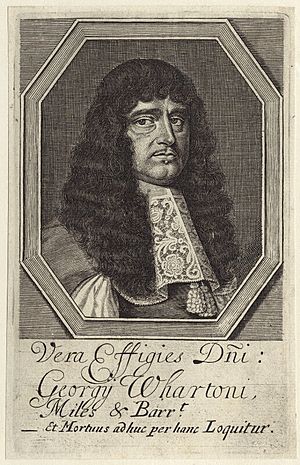Sir George Wharton, 1st Baronet facts for kids
Sir George Wharton (born April 4, 1617 – died August 12, 1681) was an interesting English person who lived a long time ago. He was a soldier, a writer, and someone who studied the stars, called an astrologer. He also held an important job as the Treasurer of the Ordnance, which meant he managed supplies for the army, like weapons and gunpowder.
Contents
The Life of Sir George Wharton
Early Years and Joining the Royalists
George Wharton was born in Westmorland, England. His father was a blacksmith. George tried to study at Oxford, but he wasn't officially accepted into the university.
In 1642, a big war started in England called the English Civil War. George decided to support King Charles I and the Royalist side. He sold his family's land to raise money. With this money, he put together his own group of horse soldiers to fight for the King.
Fighting in the English Civil War
George Wharton and his soldiers fought in many battles. They were part of the Royalist army that lost a battle at Stow-on-the-Wold in 1643. It is believed he served under a famous general named Jacob Astley, 1st Baron Astley of Reading.
Later, George went to see King Charles I in Oxford. The King gave him a job helping to manage supplies for the army. This was under another important person, Sir John Heydon.
Friendship and Astrology
During this time, George became good friends with a man named Elias Ashmole. Ashmole was also interested in many things, including history and astrology. George helped Ashmole get a job in the army too.
In 1647, George Wharton and Elias Ashmole went to the first meeting of a group called the Society of Astrologers. This meeting was held at Gresham College. It was interesting because some people there, like William Lilly and John Booker, had supported the other side in the Civil War. They had even written against George in pamphlets.
Imprisonment and Release
In 1649, after the Royalists lost the war, George Wharton was put in prison. He might have been in serious trouble, but his former opponent, William Lilly, spoke up for him. Lilly talked to an important leader named Bulstrode Whitelocke.
George was eventually set free thanks to his friend Elias Ashmole. Ashmole then gave George a job managing his large properties in Berkshire.
Return to Power and New Title
When King Charles II returned to the throne in 1660 (an event called the English Restoration), George Wharton's luck changed. He got his old job back, helping to manage army supplies.
In 1670, he was promoted to a very important position: Treasurer of the Ordnance. This meant he was in charge of all the weapons, gunpowder, and military equipment for the whole country. He kept this job until he passed away. In 1677, the King honored him by making him a baronet, which is a special title.
Sir George Wharton's Writings
Almanacs and Newsbooks
George Wharton was also a busy writer. In 1641, he wrote his first almanac, which is like a yearly calendar with predictions and information. For this first one, he used a pen name, George Naworth.
After that, he published an almanac almost every year. From 1645 onwards, he used his own name. He didn't publish in 1646, but then continued from 1647 to 1666. His almanacs became bigger and included history lessons too.
George was also a writer for the Royalist side during the Civil War. He wrote for a type of newspaper called a newsbook. His newsbook was called Mercurius Elencticus, which he started in 1647.
Writing Against Opponents
In his newsbook, George often made fun of the Parliamentarian leaders. He also wrote about their lives. When George was in prison, his newsbook continued with help from another writer, Samuel Sheppard.
George Wharton often wrote against other writers and astrologers who supported the Parliamentarian side. For example, he attacked John Hall, who wrote Mercurius Britanicus. He also wrote against John Booker, another astrologer who was on the Parliamentarian side.
After George Wharton passed away, all his collected writings were put together and published by a man named John Gadbury in 1683.


